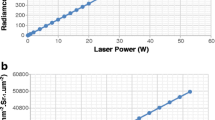Abstract
The criteria for the design of optical arrangements for laser anemometry are formulated for reference-beam, two-beam and single-beam modes of operation. The dependence of useful light intensity upon optical path-length difference and number of axial laser modes is calculated. Laser power requirements are evaluated and the dependence upon band-pass filtering is quantitatively assessed. A new two-channel integrated-optical unit, with light-path compensation, and embodying the proposed design criteria, is described.
Similar content being viewed by others
Abbreviations
- c :
-
velocity of light
- D 1/e :
-
diameter of laser beam at 1/e-point
- d :
-
half distance separating the beams leaving the lens
- d m :
-
effective diameter of measuring control volume
- d ph :
-
diameter of aperture in front of photo-multiplier
- d r :
-
waist diameter of focused reference beam
- d s :
-
waist diameter of scattering light beam
- d l :
-
waist diameter of fucused light beam
- F :
-
f-number of lens
- χ :
-
scattering function introduced in Mie's theory
- f :
-
signal frequency
- Δf :
-
bandwidth of filter
- Δf D :
-
Doppler line width of laser radiation
- Δf G :
-
effective bandwidth of gain envelope of a laser
- Δf M :
-
frequency difference between two adjacent axial modes
- h :
-
Planck constant (6.6256×10−34J sec)
- K 2π/λ :
-
wave number
- L :
-
cavity length of laser
- l m :
-
length of measuring control volume
- m :
-
total number of axial modes of laser
- M :
-
magnification (≡a/b)
- N fr :
-
number of fringes in crossing region of the two light beams
- N ph :
-
number of fringes seen by photomultiplier
- N s :
-
number of photons scattered per particle passage
- N e :
-
number of electrons leaving photo cathode per unit time
- P l :
-
total light power emitted by laser
- P s :
-
total light power scattered by particle
- Q scat :
-
scattering coefficient
- R :
-
distance from particle centre to point on plane of observation
- r p :
-
radius of scattering particle
- u :
-
velocity component perpendicular to fringe pattern
- Δχ fr :
-
distance between fringes inside measuring control volume
- η c :
-
efficiency of light collecting system\(\left( { \equiv \int {\int\limits_\Omega {IR^2 d\Omega /\mathop{{\int\!\!\!\!\!\int}\mkern-21mu \bigcirc} {IR^2 d\Omega } } } } \right)\)
- η q :
-
overall quantum efficiency of photodetector
- g q :
-
coordinate measuring angle from the optical axis
- φ :
-
half angle between wave fronts
- λ :
-
wave length of light
- υ :
-
frequency of incident light wave
- ∑e :
-
standard deviation of electron flux
- τ :
-
transit time of scattering particle
- Ω :
-
solid angle
- dω :
-
solid angle element
References
J. W. Foreman, E.W. George, J. L. Jetton, R. D. Lewis, J. R. Thornton, andH. J. Watson, I.E.E.E.,J. of Quant. Electr. QE-2 (1966) 8, 260–266.
E. Rolfe, J. K. Silk, S. Booth, K. Meister, andR. M. Young,NASA (1968) CR-1199.
W. K. George andJ.L. Lumley, The measurement of turbulence using a laser-Doppler velocimeter. Penn. State Univ. Report (1970).
R. J. Goldstein andD. K. Kreid,J. Appl. Mech. 34E, (1967) 813–818.
R. J. Goldstein andW. F. Hagen,Phys. of Fluids 10 (1967) 1349–1352.
F. Durst andJ. H. Whitelaw, Imperial College, Mech.Eng.Dept. Report ET/TN/A/15 (1972).
L. E. Drain,J.Phys.D. 5 (1972) 481–495.
F. Durst andJ. H. Whitelaw,J. Phys. E. 4 (1971) 804–808.
Idem, DISA Information 12 (1971) 11–16.
F. Durst, A. Melling, andJ. H. Whitelaw,Combustion and Flame 18 (1972) 197–201.
R. L. Bond, Measurements of the intensity of turbulence. Electronics Dept. Report, University of Arkansas Graduate Institute of Technology (1968).
F. Durst andJ. H. Whitelaw,Progress in Heat and Mass Transfer,4 (1970) 311–331.
Idem, Proc. Roy. Soc. A324 (1971) 157–181.
J. W. Foreman,Applied Optics 6 (1967) 821–826.
A. R. Bloom,Proc. IEEE. 54 (1966) 1262–1276.
H. C. van der Hulst, ‘Light scattering by small particles’ (J. Wiley, 1957).
F. Durst, Development and Application of Optical Anemometers. Ph.D. Thesis, University of London (1972).
Author information
Authors and Affiliations
Rights and permissions
About this article
Cite this article
Durst, F., Whitelaw, J.H. Light source and geometrical requirements for the optimization of optical anemometry signals. Opto-electronics 5, 137–151 (1973). https://doi.org/10.1007/BF01414734
Received:
Revised:
Issue Date:
DOI: https://doi.org/10.1007/BF01414734




